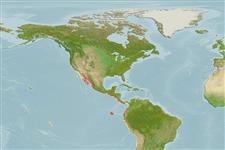Actinopterygii (ray-finned fishes) >
Perciformes (Perch-likes) >
Serranidae (Sea basses: groupers and fairy basslets) > Grammistinae
Etymology: Rypticus: Greek, ryptikos, -e, -on = easy to wash (Ref. 45335).
Environment / Climate / Range
Ecology
Marine; reef-associated; depth range 3 - 60 m (Ref. 5227). Tropical, preferred ?
Eastern Pacific: Gulf of California (rare at Puerto Peñasco) to northern Peru.
Size / Weight / Age
Maturity: Lm ? range ? - ? cm
Max length : 20.3 cm TL male/unsexed; (Ref. 5592)
Dorsal
spines
(total): 2;
Dorsal
soft rays
(total): 24-28;
Anal
soft rays: 14 - 18;
Vertebrae: 24. Sides of body heavily marked with well-defined cream spots on dark background, extending onto head, cheeks and median fins; larger spots frequently ocellated; belly with articulated pattern, cream stripe on nape; dark band running laterally from lips to eye and continuing posteriorly to blend into background anterior to dorsal fin. Body and head, excluding lips and maxillary, with embedded scales. Dorsal spines 2 (rarely 3). Lower jaw not much projecting, lacking fleshy protuberance. Juvenile and adult with 4 large, distinct oval pores along preopercular margin and 4 pairs on ventral surface of lower jaw, except in > 6.5 cm SL specimens, most posterior pair may be divided into a few smaller pores (Ref. 40934).
Little is known about this shy and secretive species. It lies motionless, often on its side, hidden in dark recesses on rocky reefs and along walls during the day. Actively hunts at night, preying on small fish (Ref. 5227).
Life cycle and mating behavior
Maturity | Reproduction | Spawning | Eggs | Fecundity | Larvae
Thomson, D.A., 1987. Reef fishes of the Sea of Cortez. The rocky-shore fishes of the Gulf of California. The University of Arizona Press, Tucson. 302 p. (Ref. 5592)
IUCN Red List Status (Ref. 115185)
CITES (Ref. 94142)
Not Evaluated
Threat to humans
Harmless
Human uses
Aquarium: potential
More information
Common namesSynonymsMetabolismPredatorsEcotoxicologyReproductionMaturitySpawningFecundityEggsEgg development
ReferencesAquacultureAquaculture profileStrainsGeneticsAllele frequenciesHeritabilityDiseasesProcessingMass conversion
Tools
Special reports
Download XML
Internet sources
